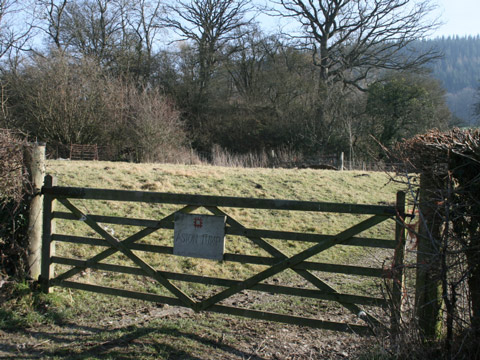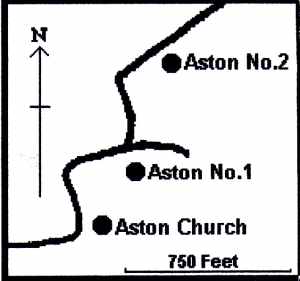Aston Castles
Pipe Aston is on the unclassified road between Wigmore and Ludlow in North Herefordshire. Aston is called Pipe Aston because of its historical links with the manufacture of clay pipes.
The remains of the castles are very close to the important Norman church.
SO 461718
Acknowledgements: Paul Remfry & John Kenyon
For more information see http://www.castles99.ukprint.com/Essays/England/Midlands/aston.html
The two castles at Aston stand roughly half way between the centres of two baronies, four miles to the east of Wigmore castle and three miles to the west of Ludlow castle It is unusual to have two castles so closely sited and when this does happen one is often more powerful than the other. This is certainly true of the two castles at Aston and it would appear here, as at similar sites, that the weaker fortress was the siege castle* of the stronger. During the ‘Anarchy’ of King Stephen’s reign Hugh Mortimer of Wigmore (d1188) was recorded as being at war with Josce de Dinan of Ludlow (d1166) sometime between 1139 and 1148.


It was probably during this unsettled period that the first and major Aston castle, known as Aston No.1, was built. The Mortimers, with their main castles at Wigmore, Dinieithon and Cleobury, would seem unlikely to have built a castle in the secure Aston manor at an earlier period. This minor holding lay a long way from any military threat before 1136 and was not an early castle site which supported their main fortress at Wigmore. In 1138 a general war began in Herefordshire and spread eastwards as lawlessness gripped England. In 1139 Miles of Gloucester, Earl of Hereford (d1143) joined Gilbert Lacy (d>1163) in rebellion in Herefordshire and Shropshire bringing much instability to the region. Hugh Mortimer took the part of King Stephen against the rebels who fought for the legitimate cause of the Empress Matilda of Germany. The war had come to an end by 1150 when Hugh Mortimer had made his peace with the rebels. It would also seem unlikely that the siege castle, Aston No.2, dates from after October 1154 when Henry II (1154-89) came to the throne and peace returned to England. From what evidence there is, it would seem best to interpret Aston No.2 as a baronial siege castle* of the mid 1140’s to early 1150’s, possibly built by Joyce Dinan to besiege Hugh Mortimer’s relatively recent castle of Aston No.1.
Aston Castle 1
The motte consists of a typical castle mound some 30 feet high. It is still surrounded by a damp and periodically flooded moat. The octagonal motte top is about 50 feet across and to the south are the foundations of what would appear to have been one side of an octagonal tower keep, probably similar to the one found at nearby Richards Castle. The motte’s slopes have much loose stone tumbled down the sides and into the moat. The implication from the above is that Aston No.1 consisted of a stone tower on a motte, which probably dates to the Anarchy or slightly earlier. To the west of the motte No.1 is a roughly rectangular field bounded by a short, but steep drop to the road to west and north, and by a stream which feeds off the motte moat to the south. This was undoubtedly the castle bailey for the No.1 motte. The stream to the south of the bailey has been diverted in recent times and this has cut into the old bailey rampart showing that it is made up primarily of a stream washed gravel. Entrance to the bailey was probably to the north as the suggested siege castle covers this side of the fortress. There its fire could impede soldiers entering or leaving Aston No.1. This would surely have been a primary responsibility of the besiegers in Aston No.2.
Aston Castle 2
Some 700 feet to the north of Aston No.1 is a much denuded motte and bailey, now known as Aston No.2. This consists of a low, ditched motte about 75 feet across, much destroyed to the south and east. The ditch which is best preserved to the north is only a few feet deep and the scarp of the mound behind it is only about five feet above the ditch bottom. To the south the mound has been mostly ploughed out, but a good green crop mark of the ditch’s original position is often apparent. A stream running between the mound and the metalled road to the north provides a steep sided gully which protected this front from attack. The weak and irregular bailey seems to have lain towards Aston motte No.1 some 700 feet to the south-east. This too has been heavily denuded to the south. There is also a possible bailey to the east. The flimsiness and lack of masonry at Aston No.2 would seem to leave little room for doubt that this was the siege castle of Aston No.1 and not the other way around.
*siege castle = a temporary castle built to house and protect troops besieging a town or castle